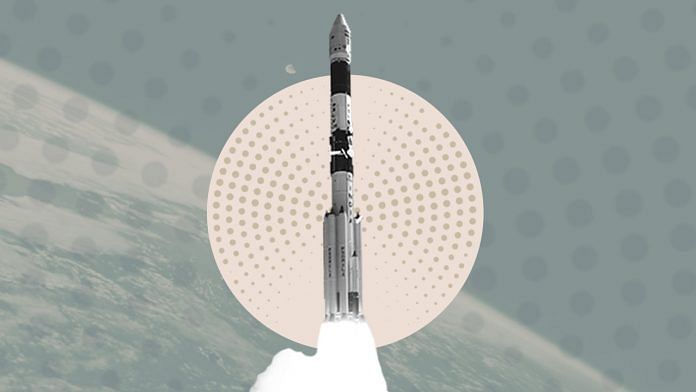In an effort to increase its outreach, ISRO has announced that it will launch a TV channel to inculcate ‘scientific temper’ among Indians. To be named ISRO TV, the channel will start telecasting science programmes within the next four months. Meanwhile, the space agency continues to remain largely inactive on social media.
ThePrint asks: Should ISRO be launching a new TV channel or focus on social media instead?
ISRO can no longer contain itself to just news flash and must build online presence
 Karan Jani
Karan Jani
Gravitational wave astrophysicist, science policy adviser, and a science communicator
I am so glad India is finally getting a dedicated TV channel for science, especially considering no news media highlights the amazing scientific advancements being made across the country.
I also strongly feel that the TV channel has to be supplemented with social media presence. A good example of this is NASA TV. Even though NASA has their own TV channel, they have expanded their outreach through diligent and dedicated social media presence. Whether it be on Twitter, Facebook or even Instagram, it is imperative for ISRO to build a brand around itself online and not just with TV.
ISRO should ideally roll out building its brand with a TV channel but have social media as its long-term strategy. This would be a great tool for building a fan base, something that would inspire students and draw attention to ISRO’s work. There is a lot ISRO can do for the community, such as Reddit AMAs or live Instagram stories, which can offer a peek into the daily lives of scientists. At some point in the future, it should also monetise into its fanbase by expanding to include ISRO merchandise, just the way NASA, ESA, and other space agencies do.
Also, the scope of such a TV channel should go beyond space and into scientific areas and inter-disciplinary collaborations.
ISRO should evaluate every year on how to quantify their outreach initiatives, in terms of viewership, age group targeted, media engagement online, etc. ISRO can no longer contain itself to just a news flash.
Women and rural India will be left out if ISRO only focuses on social media outreach
 Narayan Prasad
Narayan Prasad
Co-founder of Satsearch and a science communicator who established NewSpace India collective
In the interest of science communication, I hope that ISRO takes both TV and social media initiatives. However, I am a big proponent of ISRO TV over social media due to the sheer reach that television has in India. According to recent surveys by Broadcast Audience Research Council (BARC), urban India currently has 84 million TV households, while TV-owning homes in rural India stand at 99 million with the total TV- viewing individuals in India at 780 million.
At the same time, Internet and Mobile Association of India (IAMAI) survey suggests that internet users in India will have reached 500 million by June 2018, with 20 per cent of users from rural India. The numbers speak for themselves.
The other major issue with internet-based outreach in India is the gender gap in digital divide with only 30 per cent of the total number of internet users being women.
TV is mostly a one-way street in communication, but its reach into rural India, where most of the heavy lifting needs to be done, is unquestionable. However, the devil lies in the details. I hope that the TV channel will cater to a wide range of local languages (and not just in Hindi and English), and shall act as a platform for both ISRO scientists as well as professional science communicators to educate and inspire people of all ages and backgrounds.
ISRO should not limit the content to its own missions but make this platform available to the larger space science community in India. I am sure that this step will do a lot of good for improving the scientific temper in the country.
Televised moon landing helped America’s scientific temper, ISRO should follow suit
 Niruj Mohan Ramanujam
Niruj Mohan Ramanujam
Astronomer, and member of the Public Outreach and Education Committee of the Astronomical Society of India
ISRO would need a balanced mix of both television and social media.
TV channels permeate through the population and that is important for science literacy. There are hardly any private channels that cover Indian science, even though there are a few hundred private channels in India. It is possible that they don’t have the time or space or marketing value required to create content on science. The only channels which actually take an effort to talk about science are government channels. A good example of a public channel doing that is Rajya Sabha TV.
ISRO, as an organisation, has a good reputation among the citizens of our country, especially the youth. ISRO should capitalise on this interest. Their report did state that the channel would not just be about ISRO and science, but also about building scientific temper. The moon landing, for example, was televised all over America when it happened 50 years ago, and it gave an enormous impetus to science education and awareness. Several thousands of students went into the sciences because of the moon landing, and NASA had the foresight to capitalise on that. NASA not only publicises its own work, but also provides educative materials for children, teachers, and parents on its website. ISRO should follow suit.
Social media is something that ISRO should work on as well. During the Mangalyaan insertion, their social media accounts were very active and engaging. Their Twitter account was informative and exciting, but all that died down in a few months. Social media caters to a different set of the population, who are given regular updates and small bytes to digest, which is also needed.
ISRO should definitely do both, with a priority on the TV channel.
Science is rarely communicated outside academic circles and ISRO TV might bridge the gap
 Shashidhar Nanjundaiah
Shashidhar Nanjundaiah
Media Educationist
One of the main problems of being a rocket scientist must be to demystify the domain for the commoner. If ISRO can manage to pique the average person’s interest, it may pave the way for more mainstream disseminators to follow suit.
There is no doubt that television rules the roost today. In the foreseeable future, as FICCI forecasts, the medium of television will continue to dominate the technology spectrum in media and entertainment.
It is true that science has not taken centre stage on television, far from it, science continues to be somewhat relegated to the bleak “education channels”. Science is rarely communicated outside academic circles—certainly, our media have all but done away with science reporting—so the new effort to bridge that gap is an exciting prospect. That’s the real opportunity for ISRO. If they must make science mainstream, they have to make it popular.
Most younger people in Western countries no longer watch television in its traditional format. Channels like Netflix and Hulu offer content that is available on smartphones and laptops. In India, digital media growth rate surpasses that of any other delivery format by multiples.
Today, content is the focus and not the technology, because it can be distributed across many mediums. As a cutting-edge technology organisation, ISRO would do well to produce content that is meant for television, but ensure that it is also available on every other format that young India uses.
With every space agency maintaining an active online presence, ISRO’s silence is deafening
 Sandhya Ramesh
Sandhya Ramesh
Assistant editor, science, ThePrint
Starting a TV channel that also caters to non-English speaking sections of our population is a great idea for science literacy. After all, there isn’t any other channel doing so at the moment. However, ISRO’s primary focus should be developing a social media presence and engaging with people as well, irrespective of where they are.
Internet use today is permeating throughout the country, and ISRO can weaponise this to increase their reach. A TV channel is a one-way communication while social media can actually make consumers feel involved and help them engage. It is also a great learning tool, with more and more science communication happening on platforms like Twitter and Instagram, which could benefit ISRO as well.
The space organisation’s social media team did a tremendous job of outreach on social media during Mangalyaan and should make it a priority to develop similar systems for permanent social media presence. Regular engagement with the community helps maintain sustained interest. After all, nearly every other space agency in the world has admirable social media teams that do a wonderful job of educating consumers.
These days, space is becoming less of a race between countries and more of a collaboration. With every space agency maintaining an active online presence and keeping citizens updated, ISRO’s silence is deafening. Even the very few tweets that come out of the social media account today are massively popular and a big source of news. While the TV channel will do a good job of educating children, the organisation should also open the doors to the taxpayer and allow us to share our sense of pride and achievement with them.
Compiled by Sandhya Ramesh and Rohini Swamy.







ISRO is very famous organisation of India. ISRO their own TV channel can help crores of our Indian citizen latest news regarding science and technologies in India.
Department of Space and Science Channel?
I support the opening of a science channel, but i think there are other agencies such the Ministry of Science and Technology (MST) that are better suited for that mandate. It is inter disciplinay in science and also has agencies under it that are capable of doing this low-science commercial activity. MST can and possible hould partner with suitable existing channels to do this. Why DOS getting into this ‘soft side of business.
Space has many challenges
Instead DOS should do several of other innovative things, for instance, .promoting in partnership with private industry a much bigger base for satellite fabrication. India can easily become the leading hub in the world in this area This growth is capped by keeping the industry with ISRO while outsourcing parts from broader industry. No, the country can have several ISROs is in the private sector, with DOS ISRO BEING A FACILITATOR as well as a monitor of national security concerns.